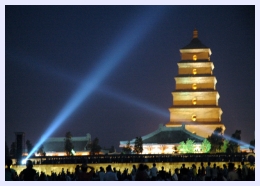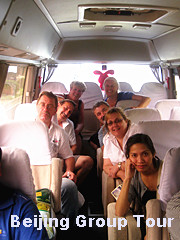 Big Wild Goose Pagoda
Big Wild Goose Pagoda
 |
Situated inside Ci'en (Thanks-giving) Temple, four kilometres south of Xi'an city, the Big Wild Goose Pagoda is a well-preserved ancient building and a holy place for Buddhists. |
 Legend had it that a group of big whild geese flew over, suddely one of them dropped and died on the ground. Monks were at a loss and didn't know what to do. They thought that the dead wild googse was a Buddha. They buried the goose and a pagoda was erected, hence the name, the Big Whild Goose Pogoda.
Legend had it that a group of big whild geese flew over, suddely one of them dropped and died on the ground. Monks were at a loss and didn't know what to do. They thought that the dead wild googse was a Buddha. They buried the goose and a pagoda was erected, hence the name, the Big Whild Goose Pogoda.
The storeyed pagoda was an architectural marvel. It was built with layers of bricks but without any cement in between. The bracket style in traditional Chinese architecture was also used in the construction. The seams between each layer of bricks and the "prisms" on each side of the pagoda are clearly visible. The grand body of the pagoda, with its solemn appearance, simple style, and high structure, is indeed a good example of ancient people's wisdom and talent.
Pictures of the Heavenly King and of Buddha are on the doorframes and horizontal bars are on four sides of the pagoda's base. These stone sculptures display peak workmanship and show vivid shapes and smooth lines. They now serve as an important source of material for the study of painting and sculpture of the Tang dynasty. Out of these artistic works, the one on the horizontal bar of the west door is the most precious. It is a rare piece of art, now used for the study of the Tang architecture.
Inside the temple where the pagoda is situated, there are two small buildings: the one on the east side houses a bell, and the one on the west side a drum. The bell, an iron cast from the Ming dynasty, weights 15 tons. Together with the drum, the bell was used to strike time for the monks in the temple.
Inside the Great Hall of the Buddha in the temple, there are three incarnations of Sakyamuni. The one in the middle is called Dharmakaya. The one on the west side is called Bao Shen Buddha, and the one on the opposite is called Ying Shen Buddha.
In the Doctrine Chamber stands the Amitabha Buddha. On the wall at the east side of the chamber, there are three rubbings. The one in the middle is called, Xuanzang (Monk Tripitaka) Carries the Scriptures to Chang'an.
In the Tang dynasty, every successful candidate who passed the imperial examinations would have to climb up the Big Wild Goose Pagoda and write poems and inscriptions there. This ritual would symbolize a soaring career in the future. The fashion of writing poems and leaving inscriptions on the horizontal bars over doors and stone frame-works by successful candidates of the imperial examinations went on as far as the Ming dynasty. These poems and inscriptions have survived to this day as a fine reflection of the city's past.
China Attractions
- Beijing Attractions
- Shanghai Attractions
- Xian Attractions
- Guilin Attractions
- Guangzhou Attractions
- Lhasa Attractions
- Yangshuo Attractions
- Hangzhou Attractions
- Nanjing Attractions
- Huangshan Attractions
- Wuhan Attractions
- Dali Attractions
- Harbin Attractions
- Suzhou Attractions
- Kunming Attractions
- Pingyao Attractions
- Xinjiang Attractions
- Kashgar Attractions
- Chengdu Attractions
- Sanya Attractions
- Lijiang Attractions
- Datong Attractions
- Dunhuang Attractions


